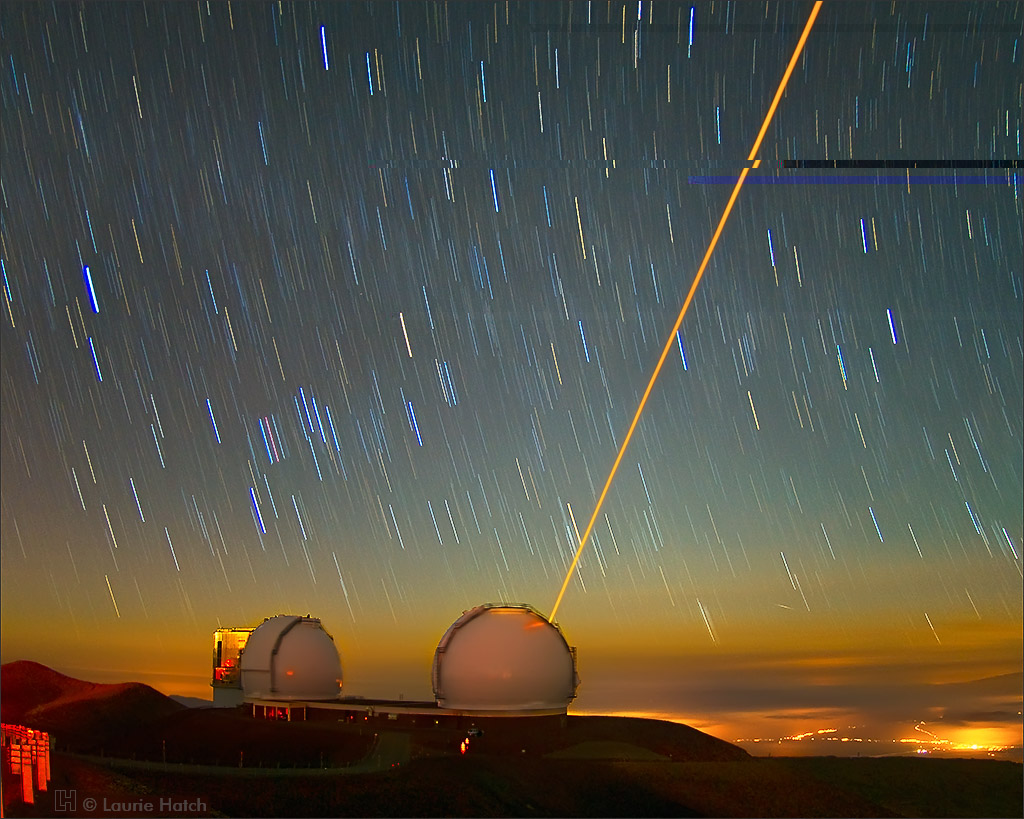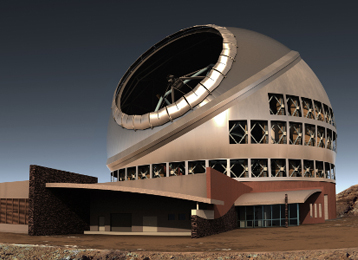
Keck Observatory - Mauna Kea, Hawaii
Our primary location for observing the SgrA* and the environs of the central galactic region is at the Keck Observatory on the summit of Mauna Kea in Hawaii. For over two decades, we have been using the 10m Keck I and Keck II telescopes, mapping the orbits of objects within one parsec of the Galactic center. Our science have greatly benefited from the Adaptive Optics (AO) the Keck telescopes have been equipped with since year 2000 ( P.L. Wizinowich et al 2000), which allows a telescope to reach its diffraction limit (i.e. the telescope's 'full potential') and produce high resolution images. We predominantly use the OSIRIS (a diffraction limited integral infrared spectrograph) and the near IR imager NIRC2 at Keck II to acheive our high-resolution images. Both the NIRC2 and OSIRIS instruments were co-developed/built/designed by the UCLA IR-Laboratory.

TMT - The Thirty Meter Telescope at the Mauna Kea Summit
The Galactic Center Group members will have access to the future 30m telescope, which is currently being built and is expecting its first light in 2022. UCLA's Division of Astronomy plays an active role in its development and design; Galactic Center Group's Prof. Andrea Ghez serves on the TMT science advisory committee, and Prof. James Larkin is the P.I. of IRIS , which a first generation near-infrared (0.85-2.5 μm) instrument designed to sample the diffraction limit of the TMT. "The 30-meter aperture permits the telescope to focus more sharply than smaller telescopes by using the power of diffraction of light. The large aperture also collects more light than smaller scopes, allowing images of fainter objects. TMT will therefore reach further and see more clearly than previous telescopes by a factor of 10 to 100 depending on the observation." Read more at TMT.org.
Additional telescopes that we use
In order to make a comprehensive picture of the Galactic Center region, the Galactic Center Group uses various telescopes spanning a wide range of wavelengths, from X-ray to radio.

Very Large Array
The Very Large Array, one of the world's premier astronomical radio observatories, consists of 27 radio antennas in a Y-shaped configuration on the Plains of San Agustin fifty miles west of Socorro, New Mexico. Each antenna is 25 meters (82 feet) in diameter. The data from the antennas is combined electronically to give the resolution of an antenna 36 km (22 miles) across, with the equivalent sensitivity of a dish 130 meters (422 feet) in diameter.

Gemini Obeservatory
The Gemini Observatory consists of twin 8.1-meter diameter optical/infrared telescopes located on two of the best observing sites on the planet. From their locations on Maunakea in Hawai‘i and Cerro Pachón in Chile, Gemini Observatory's telescopes can collectively access the entire sky. The Gemini Observatory provides the astronomical communities in six participant countries with state-of-the-art astronomical facilities that allocate observing time in proportion to each country's contribution.

Hubble Space Telescope
Named in honor of the trailblazing astronomer Edwin Hubble, the Hubble Space Telescope is a large, space-based observatory, which has revolutionized astronomy since its launch and deployment by the space shuttle Discovery in 1990. Far above rain clouds, light pollution, and atmospheric distortions, Hubble has a crystal-clear view of the universe. Scientists have used Hubble to observe some of the most distant stars and galaxies yet seen, as well as the planets in our solar system.

Strratospheric Observatory for Infrared Astronomy (SOFIA)
NASA and its partners at the German Space Agency at the Deutsches Zentrum für Luft- und Raumfahrt (DLR) will conclude the Stratospheric Observatory for Infrared Astronomy (SOFIA) mission, after a successful eight years of science. SOFIA will end operations no later than Sept. 30, 2022, at the conclusion of its current mission extension. SOFIA is a Boeing 747SP airplane modified to carry a reflecting telescope. SOFIA completed its five-year prime mission in 2019 and currently is completing a three-year mission extension.

CHANDRA X-ray telescope
NASA's Chandra X-ray Observatory is a telescope specially designed to detect X-ray emission from very hot regions of the Universe such as exploded stars, clusters of galaxies, and matter around black holes. Because X-rays are absorbed by Earth's atmosphere, Chandra must orbit above it, up to an altitude of 139,000 km (86,500 mi) in space. The Smithsonian's Astrophysical Observatory in Cambridge, MA, hosts the Chandra X-ray Center which operates the satellite, processes the data, and distributes it to scientists around the world for analysis. The Center maintains an extensive public web site about the science results and an education program.

Spitzer
NASA's Spitzer Space Telescope is a technological marvel, featuring many innovations never before used on a space mission. Launched in 2003, NASA’s Spitzer Space Telescope was the fourth and final addition to NASA’s Great Observatory program. Spitzer’s mission was to become NASA’s premier infrared light observatory, offering astronomers the chance to study the universe in this critical part of the electromagnetic spectrum of light with unprecedented clarity and sensitivity.

Subaru Telescope
The Subaru Telescope is located on the summit of Mauna Kea on the Big Island of Hawaii. This is known as one of the best places for astronomical observation. At an altitude of 4200 meters, the summit of Mauna Kea is dry, with many sunny days, as the barometric pressure is only two-thirds of the level and is unaffected by the ground weather system. Trade winds blow smoothly over the Hawaiian Islands, and clouds rarely rise to the summit. There are no big cities nearby, and there is little artificial light that interferes with astronomical observations.